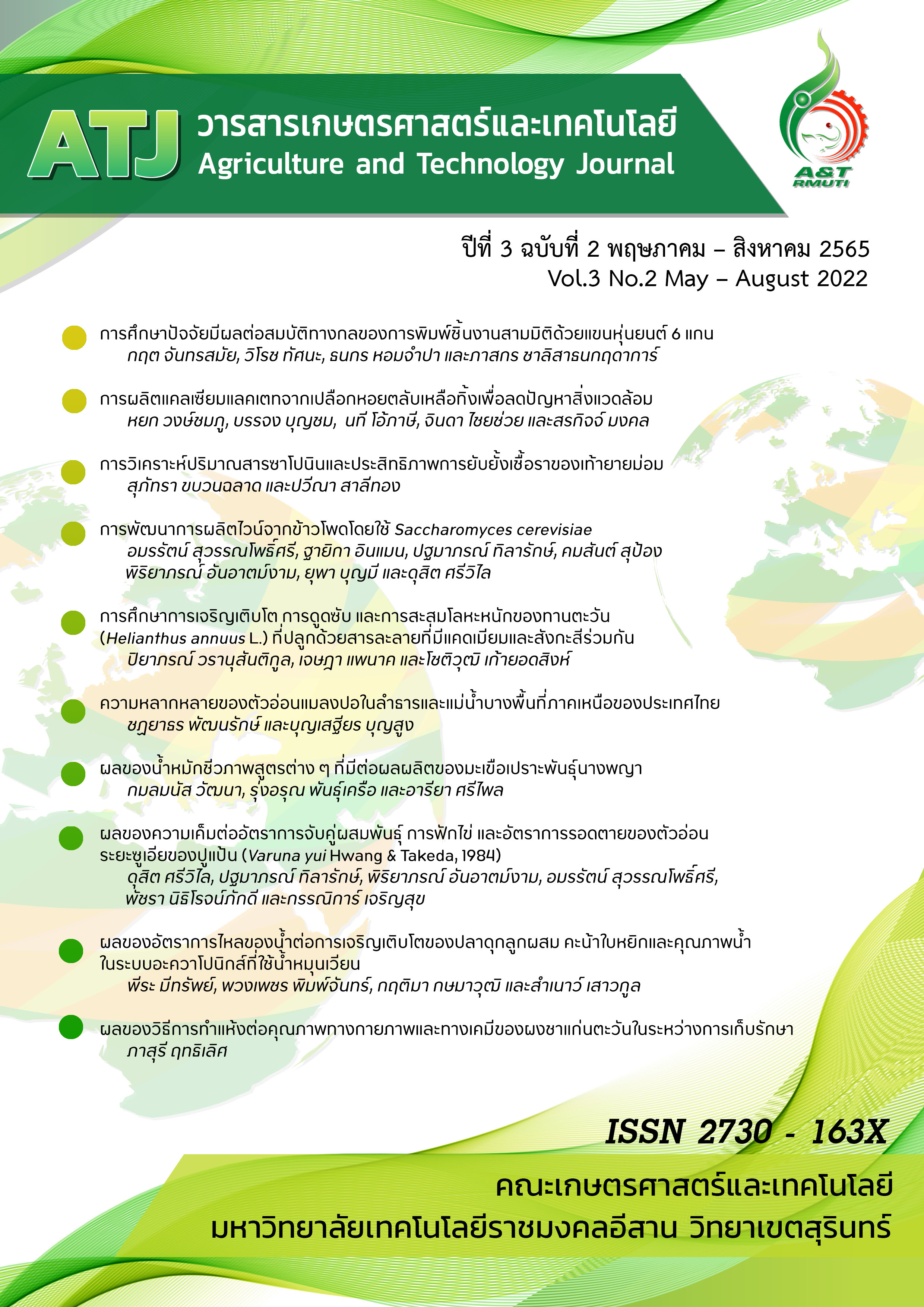การศึกษาการเจริญเติบโต การดูดซับ และการสะสมโลหะหนักของทานตะวัน (Helianthus annuus L.) ที่ปลูกด้วยสารละลายที่มีแคดเมียมและสังกะสีร่วมกัน
The studied of growth, absorption and accumulation of heavy metals by sunflower (Helianthus annuus L.) grown on Cd-Zn co-contaminated solution
คำสำคัญ:
การเจริญเติบโต, การดูดซับ , แคดเมียม , สังกะสี , ทานตะวันบทคัดย่อ
งานวิจัยนี้มีวัตถุประสงค์เพื่อศึกษาการเจริญเติบโต และการสะสมโลหะหนักของทานตะวันที่ปลูกด้วยสารละลายที่มีแคดเมียมและสังกะสีร่วมกัน โดยปลูกทานตะวันด้วยสารละลายแร่ธาตุซึ่งเติมแคดเมียมหรือสังกะสีที่ระดับความเข้มข้นต่าง ๆ เพื่อศึกษาผลกระทบของโลหะหนักต่อการเจริญเติบโตและเลือกระดับความเข้มข้นโลหะหนักที่ไม่ส่งผลกระทบต่อการเติบโตไปทดลองต่อไป ทานตะวันเติบโตได้ดีเมื่อปลูกด้วยสารละลายที่มีแคดเมียมระดับความเข้มข้นไม่เกิน 0.5 มิลลิกรัมต่อลิตร และสังกะสีระดับความเข้มข้นไม่เกิน 1.25 มิลิลกรัมต่อลิตร จากนั้นทำการทดลองการปลูกทานตะวันในสารละลายแร่ธาตุซึ่งเติมแคดเมียมที่ระดับความเข้มข้น 0, 0.1, 0.3 และ 0.5 มิลลิกรัมต่อลิตร แต่ละระดับความเข้มข้นของแคดเมียมจะเติมสังกะสีร่วมด้วยที่ระดับความเข้มข้น 0, 0.2, 0.6 และ 1 มิลลิกรัมต่อลิตร เป็นเวลา 15 วัน จากนั้นนำพืชไปวิเคราะห์การเจริญเติบโตและปริมาณโลหะหนัก ผลการศึกษาแสดงให้เห็นว่าสังกะสีซึ่งเป็นธาตุอาหารรองจะยับยั้งการเติบโตของพืชและก่อให้เกิดความเป็นพิษเมื่อพืชได้รับในปริมาณที่สูงเกินไป สังกะสีในปริมาณที่เหมาะสมสามารถส่งเสริมการเติบโตของพืชในสภาวะที่มีแคดเมียมร่วมด้วยได้ การสะสมแคดเมียมในส่วนลำต้นที่เพิ่มสูงขึ้นจะส่งผลให้ปริมาณสังกะสีในลำต้นลดลง แคดเมียมอาจส่งผลต่อการดูดซึมสังกะสีและรบกวนกระบวนการทางสรีรวิทยาของพืชที่สังกะสีมีส่วนเกี่ยวข้อง ในการศึกษานี้ยังพบว่าทานตะวันมีความสามารถในการลำเลียงและสะสมโลหะหนักแคดเมียมในส่วนลำต้นได้มากกว่า 100 มิลลิกรัม/กิโลกรัม มวลแห้ง จัดเป็นพืชที่สามารถดูดซับแคดเมียมได้ในปริมาณสูง
เอกสารอ้างอิง
กรมควบคุมมลพิษ. (2556). จดหมายข่าว ฟื้นฟูคลิตี้ ปีที่ 1 ฉบับที่ 1. ค้นเมื่อ 29 พฤษภาคม 2565. https://www.pcd.go.th/publication/6426/.
ยงยุทธ โอสถสภา. (2546). ธาตุอาหารพืช. (พิมพ์ครั้งที่ 2). สำนักพิมพ์มหาวิทยาลัยเกษตรศาสตร์: กรุงเทพมหานคร.
Abdel-Halim S.H., Shehata A.M.A. and El-Shahat M.F. (2003). Removal of lead ions from industrial waste by different type of natural materials. Water Research. 37: 1678–1683.
Adesodun J., Atayese M., Agbaje T., Osadiaye B., Mafe O. and Soretire A. (2010). Phytoremediation potentials of sunflowers (Tithonia diversifolia and Helianthus annuus) for metals in soils contaminated with zinc and lead nitrates. Water Air & Soil Pollution. 207: 195–201.
Ahalya N., Ramachandra T.V. and Kanamadi R.D. (2003). Biosorption of heavy metals. Research Journal of Chemistry and Environment. 7(4): 71–79.
Ali H., Khan E. and Sajad M.A. (2013). Phytoremediation of heavy metals – Concepts and applications. Chemosphere. 91: 869 – 881.
Baker A.J.M. (1981). Accumulators and excluders-strategies in the response of plants to heavy metals. Journal of Plant Nutrition. 3: 1–4.
Chantachon S., Krutrachue M. and Pokethitiyooketa P. (2004). Phytoextraction and accumulation of lead from contaminated soil by Vetiver grass: laboratory and simulated field study. Water Air & Soil Pollution. 154: 37–55.
Chintakovid W., Visoottiviseth P., Khokiattiwong S. and Lauengsuchonkul S. (2008). Potential of the hybrid marigolds for arsenic phytoremediation and income generation of remediators in Ron Phibun District, Thailand. Chemosphere. 70: 1532-1537.
Coleman J.E. (1992). Zinc proteins: enzymes, storage proteins, transcription factors and replication proteins. Annual Review of Biochemistry. 61: 897–946.
Francis C.W. and Rush S.G. (1973). Factors affecting uptake and distribution of cadmium in plants. In Hemphill D.D., Editor. Trace substances in environmental health. University of Missouri Press: Columbia. 75–81.
Harborne J.B. (1989). Introduction to ecological biochemistry. Academic Press: New York.
Hawf L.R. and Schmid W.E. (1967). Uptake and translocation of zinc by intact plants. Plant and Soil. 2: 249–260.
Hunt R. (2003). Growth analysis, individual plants. In Thomas B., Murphy D.J. and Murray D., Editors. Encylopaedia of applied plant science. Acedemic Press: London. 579–588.
Jadia C.D. and Fulekar M.H. (2008). Phytoremediation: the application of vermicompost to remove zinc, cadmium, copper, nickel and lead by sunflower plant. Environmental Engineering and Management Journal. 7(5): 547–558.
Jadia C.D. and Fulekar M.H. (2009). Phytoremediation of heavy metals: recent techniques. African Journal of Biotechnology. 8(6): 921–928.
Kim M.J. and Motto H.L. (1978). Effects of zinc, phosphorus and iron on the cadmium uptake and accumulation by hydroponically grown tomato. Journal of the Korean Agricultural Chemical Society. 21(1): 40–50.
Kötschau A., Büchel G., Einax J.W., Tümpling W.V. and Merten D. (2014). Sunflower (Helianthus annuus): phytoextraction capacity for heavy metals on a mining-influenced area in Thuringia, Germany. Environmental Earth Science. 72: 2023-2031.
La-up A., Mahasakpan P. and Saengow U. (2021). The current status of osteoporosis after 15 years of reduced cadmium exposure among residents living in cadmium-contaminated areas in northwestern Thailand. Environmental Science and Pollution Research. 28: 20121–20127.
Mattina M.J.I., Lannucci-Berger W., Musante C. and White J.C. (2003). Concurrent plant uptake of heavy metals and persistent organic pollutants from soil. Environmental Pollution. 124: 375–378.
Newman L.A., Strand S.E., Choe N., Duffy J., Ekuan G., Ruszaj M., Shurtleff B.B., Wilmoth J., Heliman P. and Gordon M.P. (1997). Uptake and biotransformation of trichloroethylene by hybrid poplars. Environmental Science & Tehnology. 31(4): 1062–1067.
Pandey N. and Sharma C.P. (2002). Effect of heavy metals Co, Ni and Cd on growth and metabolism of cabbage. Plant Science. 163: 753–758.
Phaenark C., Pokethitiyook P., Kruatrachue M. and Ngernsansaruay C. (2009). Cd and Zn accumulation in plants form the Padaeng Zn mine area. International Journal of Phytoremediation. 11: 479–495.
Reinhold J.G., Faradji B., Abadi P. and Ismall-Beigi F. (1976). Decreased absorption of calcium, magnesium, zinc and phosphorus by humans due to increased fiber and phosphorus consumption as wheat bread. The Journal of Nutrition. 106(4): 493–503.
Robinson N.J., Urwin P.E., Robinson P.J. and Jackson P.J. (1994). Gene expression in relation to metal toxicity and tolerance. Harwood Academic Publisher: New York.
Root R.A., Miller R.J. and Koeppe D.E. (1975). Uptake of cadmium-its toxicity, and effect on the iron ratio in hydroponically grown corn. Journal of Environmental Quality. 4(4): 473–476.
Rotkittikhun P., Chaiyarat R., Krutrachue M., Pokethitiyook P. and Baker A.J.M. (2007). Growth and lead accumulation by the grasses Vetiveria zizanioides and Thysanolaena maxima in lead-contaminated soil amended with pig manure and fertilizer: A glasshouse study. Chemosphere. 66: 45-53.
Rotkittikhun P., Kruatrachue M., Chaiyarat R., Ngernsansaruay C., Pokethitiyook P., Paijitprapaporn A. and Baker A.J.M. (2006). Uptake and accumulation of lead by plants from the Bo Ngam lead mine area in Thailand. Environmental Pollution. 144: 681-688.
Shaheen S.M. and Rinklebe J. (2015). Phytoextraction of potentially toxic elements by Indian mustard, rapeseed, and sunflower from a contaminated riparian soil. Environmental Geochemistry and Health. 37: 953–967.
Simmons R.W., Pongsakul P., Saiyasitpanich D. and Klinphoklap S. (2005). Elevated levels of cadmium and zinc in paddy soils and elevated levels of cadmium in rice grain downstream of a zinc mineralized area in Thailand: Implications for public health. Environmental Geochemistry and Health. 27: 501–511.
Smith G.C. and Brennan E. (1983). Cadmium–zinc interrelationships in tomato plants. Phytopatholgy. 73: 879–882.
Visoottiviseth P., Francesconi K. and Sridokchan W. (2002). The potential of Thai indigenous plant species for the phytoremediation of arsenic contaminated land. Environmental Pollution. 118(3): 453-461.
Waranusantigul P., Kruatrachue M., Pokethitiyook P. and Auesukaree C. (2008). Evaluation of Pb phytoremediation potential in Buddleja asiatica and B. paniculata. Water Air & Soil Pollution. 193: 79-90.
Zekri M. and Obreza T.A. (2003). Micronutrient deficiencies in citrus: iron, zinc, and manganese. University of florida: Florida.
ดาวน์โหลด
เผยแพร่แล้ว
เวอร์ชัน
- 19-02-2024 (2)
- 30-08-2022 (1)
รูปแบบการอ้างอิง
ฉบับ
ประเภทบทความ
สัญญาอนุญาต
ลิขสิทธิ์ (c) 2022 วารสารเกษตรศาสตร์และเทคโนโลยี

อนุญาตภายใต้เงื่อนไข Creative Commons Attribution-NonCommercial-NoDerivatives 4.0 International License.
เนื้อหาและข้อมูลในบทความที่ลงตีพิมพ์ในวารสารทดสอบระบบ ThaiJo2 ถือเป็นข้อคิดเห็นและความรับผิดชอบของผู้เขียนบทความโดยตรงซึ่งกองบรรณาธิการวารสาร ไม่จำเป็นต้องเห็นด้วย หรือร่วมรับผิดชอบใดๆ
บทความ ข้อมูล เนื่อหา รูปภาพ ฯลฯ ที่ได้รับการดีพิมพ์ในวารสารทดสอบระบบ ThaiJo2 ถือเป็นลิขสิทธิ์ของวารสารทดสอบระบบ ThaiJo2 หากบุคคลหรือหน่วยงานใดต้องการนำทั้งหมดหรือส่วนหนึ่งส่วนใดไปเผยแพร่หรือเพื่อกระทำการใดๆ จะต้องได้รับอนุญาตเป็นลายลักอักษรณ์จากวารสารทดสอบระบบ ThaiJo2 ก่อนเท่านั้น







